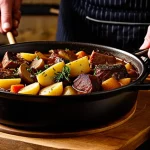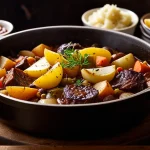Understanding Outdoor Cooking Safety
When it comes to outdoor cooking, safety should always be a top priority. With the right precautions, cooking outside can be a delightful experience without risk.
Outdoor cooking hazards often center around fire safety. Ensuring an appropriate distance from flammable materials is crucial. Always set up your cooking area on a stable surface away from overhanging branches or dry leaves. Extinguish fires completely to prevent any unintended flare-ups.
Also to see : Easy urban composting: creating an odor-free kitchen waste solution for apartment dwellers
Firewood safety is another critical aspect of outdoor cooking. Proper handling and storage of firewood can significantly reduce risks. Always store firewood in a dry place away from your living areas to prevent pest infestations. When handling firewood, wear gloves to avoid splinters and ensure any tools you use are adequately maintained to prevent accidents.
Additionally, understanding common outdoor cooking hazards is essential. Gas grills can leak, requiring regular inspections of hoses and connections. Charcoal grills need to be placed on a flat surface and monitored to prevent tipping over. By keeping these safety tips in mind, you can enjoy a delicious meal outdoors while keeping everyone safe.
Also to read : Thriving indoor tropics: uncover the secrets to creating a vibrant plant haven in the uk’s cool climate
Designing the Layout of Your Outdoor Cooking Area
Planning your outdoor cooking layout is essential for creating a functional and enjoyable space. Consider convenience and safety in your outdoor kitchen design. Start by choosing a location that provides easy access to your indoor kitchen and utilities. This minimizes trips back and forth, making meal preparations smoother.
When zoning your outdoor cooking layout, create distinct areas for cooking, dining, and firewood storage. Position the cooking zone with adequate ventilation and away from dining spaces to prevent smoke from becoming a nuisance. Ensure there’s enough counter space around your grill or stove for preparation and cooling.
A well-thought-out outdoor kitchen design includes proper spacing and access to cooking equipment. Maintain a safe distance between the grill and seating areas to prevent accidents. Store firewood within arm’s reach of the grill but shielded from weather elements to ensure it’s dry when needed.
Integrating thoughtful space planning can elevate your outdoor space. Ensure pathways are wide enough for easy access, preventing crowding while entertaining. With the right layout, your outdoor area will not only boost functionality but also enhance your cooking experience. Remember, a successful design balances aesthetics with practicality.
Selecting Materials for Durability and Functionality
Choosing the right outdoor cooking materials is vital for ensuring the longevity and effectiveness of your cook area. When designing your space, consider materials that are not only durable but can also withstand the challenges posed by weather conditions. Weather-resistant materials are paramount. For countertops, granite and stainless steel rank highly due to their strength and resistance to the elements. Granite is particularly prized for its natural beauty and the way it seamlessly blends with the outdoor environment, making it both functional and aesthetically pleasing.
For cooking surfaces, ceramic and stainless steel are leaders in durability. They provide robustness against high temperatures and are easy to clean. Structures such as cabinetry should ideally use powder-coated metals or treated woods, which are designed for weather-resistant performance.
The cook area durability also depends significantly on maintenance practices. Regular sealing of stone countertops and cleaning of metal surfaces can prolong the material life. While on the practicality side, remember to weigh aesthetics as a factor. The harmony between functionality and appearance in material selection can elevate your outdoor cooking experience, making it both a visual and culinary delight.
Innovative Firewood Storage Solutions
Finding practical ways to keep firewood organized and dry is essential. Outdoor firewood racks and storage ideas play a crucial role in maintaining both functionality and aesthetics in yard space.
Choosing Between Racks and Bins
While racks offer an easy, open solution, they excel in ensuring airflow, preventing moisture trapping. However, they may leave the wood exposed to weather elements. On the other hand, bins provide excellent protection against rain and snow, helping to keep firewood dry. Yet, limited airflow may lead to mold if not managed correctly.
When deciding on organized firewood storage, consider the following factors:
- Space Availability: Opt for compact racks if space is limited.
- Aesthetic Preferences: Racks tend to blend seamlessly with rustic themes, while bins can be more versatile in design.
- Climate Considerations: Choose racks for drier climates and bins for wetter areas where moisture is a concern.
Tips for Maintaining Firewood Quality
To keep firewood in top condition, store it off the ground, preferably in a location exposed to the sun. Using a tarp can be beneficial to protect it from rain while still allowing airflow from the sides. Regularly checking for pests and rot is also key in effective maintenance.
Best Practices for an Organized Outdoor Cooking Experience
When it comes to organized outdoor cooking, a meticulously arranged setup significantly uplifts the entire experience. Begin by designating a functional cooking area. This can be achieved by cleverly using surfaces such as portable tables or built-in counters to keep all utensils and ingredients within arm’s reach. Investing in cabinets or portable storage units aids in managing clutter, providing ample space for pots, pans, and cooking tools within a compact, easy-to-access location.
Regular cleaning and maintenance routines are fundamental. Food residues and grease can accumulate quickly, especially after a lively barbecue session. It’s crucial to establish a habit of wiping down surfaces, clearing debris, and thoroughly cleaning grills and burners post-use. This routine keeps your cooking space hygienic and prolongs the lifespan of your appliances.
To maximize space and efficiency, consider tiered shelving or wall-mounted racks. These solutions help utilize vertical space, allowing you to store spices, oils, and utensils neatly, freeing up counter space for food preparation. Implementing these strategies ensures your outdoor kitchen is not only aesthetically pleasing but also highly functional, making any outdoor cooking activity both seamless and enjoyable.
Visual Aids and Resources
Transforming your outdoor space into a dream cooking area often requires more than just imagination. Visual guides can serve as important outdoor cooking resources by providing layout ideas and functional tips. Websites like Houzz and Pinterest offer numerous images and designs for outdoor kitchens that ignite creativity. These platforms are packed with photos of varied setups which can fuel your creativity.
Digital tools and apps, such as Home Design 3D and Houzz, enable you to visualize your plans in a structured form before undertaking any projects. These applications offer drag-and-drop features, allowing you to modify designs, rearrange furniture, and simulate your space in 3D. This ensures that every component seamlessly integrates, from the grill to seating areas, helping you avoid costly mistakes.
Examining successful outdoor cooking setups is another great way to gather inspiration. Look for examples that highlight efficient use of space and innovative ideas, such as built-in barbecues, pizza ovens, fire pits, and cozy seating options. These setups can guide decisions concerning materials, appliances, and overall aesthetics, ensuring that your kitchen is both practical and gorgeous. With the right resources, transforming your backyard into a culinary haven is entirely possible.











